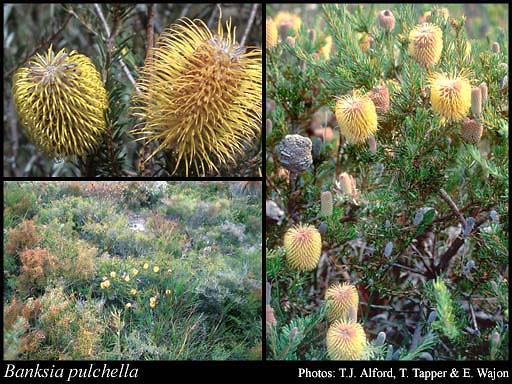- Reference
- Trans.Linn.Soc.London 10:202 (1810)
- Conservation Code
- Not threatened
- Naturalised Status
- Native to Western Australia
- Name Status
- Current
Non-lignotuberous shrub, 0.2-1.5 m high. Fl. yellow-orange-brown, Jan or Mar or May to Oct. White or grey sand. Coastal sandhills, sandplains.

Scientific Description
Shrubs, 0.30-1 m high; branchlets glabrous or hairy. Leaves petiolate, alternate, 10-17 mm long, 1-1.3 mm wide, hairy; petiole 1-1.5 mm long; lamina flat, more or less the same width throughout, entire, the margins revolute. Inflorescences tomentose (with matted or tangled, soft, woolly hairs), yellow; innermost bracts 3-5 mm long, hairy. Perianth 8-9 mm long, glabrous, without awns; pistil 17-23 mm long, hooked, style glabrous. Follicles hairy, hirsute (with long, rough and coarse hairs), elliptic, 8-17 mm long. Flowers in January, February, March, April, May, June, July, August, September or October. Occurs in the South-west (SW) Botanical Province(s), in the Mallee (MAL) or Esperance Plains (ESP) IBRA subregion(s).
Distribution
- IBRA Regions
- Esperance Plains, Mallee.
- IBRA Subregions
- Eastern Mallee, Fitzgerald, Recherche, Western Mallee.
- IMCRA Regions
- Eucla, WA South Coast.
- Local Government Areas (LGAs)
- Esperance, Ravensthorpe.